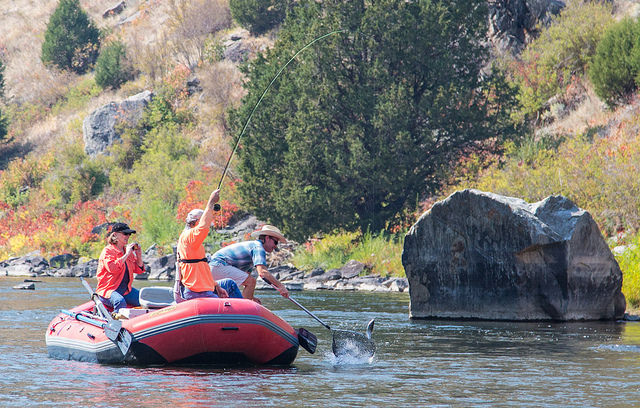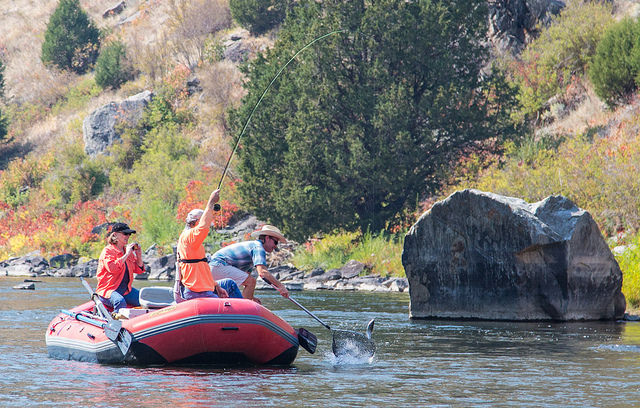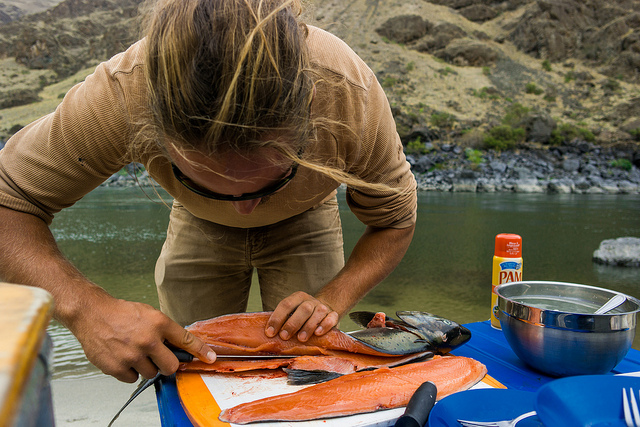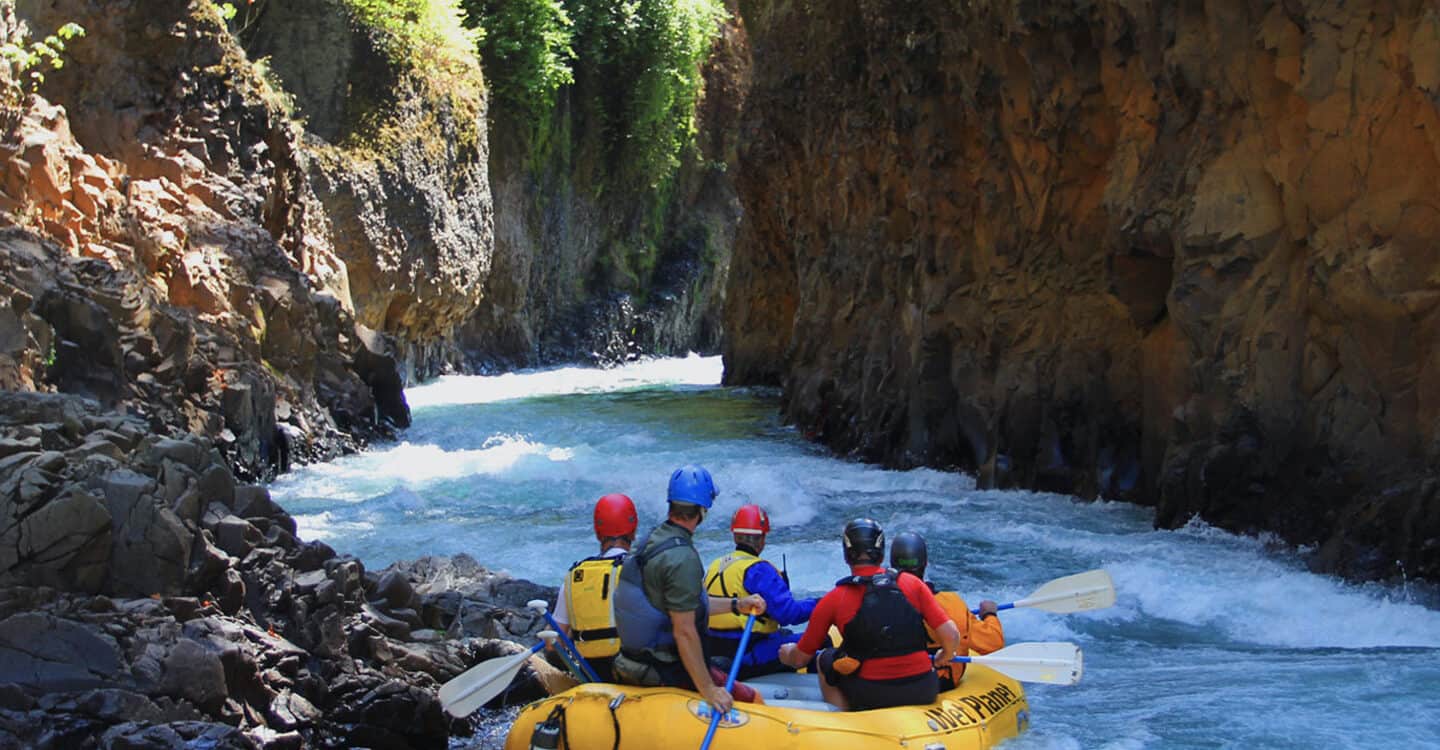The following Q&A is courtesy of Jeanette Burkhardt, watershed planner for Yakama Nation Fisheries. Wet Planet is proud to partner with Jeanette on projects like this blog series and RiverFest.
Q: How can rafters and kayakers mitigate their impact on fish?
A: Good question, and one with many answers. There are immediate impacts to fish, such as angling for them (which some boaters do) or disturbing them on redds when they are trying to spawn. It’s tricky, because harassing listed species is illegal, yet fishing for them is allowed (under specific conditions—see WDFW regs).
- Always know the regulations before you fish, and only keep adipose-clipped (hatchery) fish. Wild fish need all the help we can give them, so if you catch a wild fish, be sure to know how to lessen the impacts from hooking and handling.
- Passing boats and wading boaters can displace spawning fish:
- Causes reduced energy reserves for adult salmon23
- Repeated disturbance could cause fish to select less suitable sites for spawning
- Grounded boats and wading boaters can damage eggs in gravel by trampling
These disturbances can result in reduced reproductive success and/or premature death of these threatened fish.
- Avoid stepping on or dragging paddles, oars or boats across shallow gravel instream, since this may have been/or is being used by spawning fish. Learning to recognize what a redd looks like—a lighter colored area on the river or stream bottom where the salmon or steelhead have cleaned off the gravel and dug a depression to lay their eggs—is a great way to be able to spot redds and spawning fish and avoid them (give them a wide berth) when paddling. When fish are spawning, they will often stay close to or on their redds to guard them, so you may see a fish hanging out by one of these lighter areas, or even chasing other fish off. However, after the spawning fish have died, it is still important not to disturb these redds, as the developing eggs are vulnerable and can be crushed by paddles or oars, be stepped on or suffocated by too much fine sediment clogging up the spaces between the gravel through which oxygen-rich water flows to the developing eggs. Environmental inputs of fine sediment—whether from point sources or cumulative impacts from erosion—can be detrimental to salmon during all stream life stages, but especially in the incubation phase. So, to sum it up:
Measures Boaters can take to Reduce Impacts:
- Stay at least 25 feet (or as far away as safely possible) from spawning adult salmon and redds
- Pass by spawning salmon and redds as quickly as possible
- Observe from a distance and take care not to disturb fish
- Do not strike redds with boat, oars, or paddles
- Do not step on or near redds
…and there are longer term impacts to fish.
- Keep wood in the river. Large wood is also a key component of instream habitat for fish. Wood in the stream can be a human hazard in rare instances, but often it is merely an inconvenience. Every effort should be made to keep wood in the stream and along the banks, as it provides critical habitat to fish during all stream life stages—whether for juveniles holding and feeding downstream of woody debris, or adults holding and resting in the slower water or pools created by wood. Wood also helps to sort gravels, which salmon and steelhead need to spawn. If you encounter wood that is an imminent danger to people, property, or the environment in the White Salmon, call WDFW (numbers below in “resource” link section). Only in rare instances should large wood in the river be cut, and only then with a hydraulic permit (HPA) from WDFW. Just remember: Wood is good!
- Clean, Drain, Dry your craft! Cleaning your water craft (even SUPs!) after you leave a water body is also critical—never launch a dirty boat! Thus far, the White Salmon doesn’t have aquatic invasive species like New Zealand mud snails, which have infested the Deschutes and other nearby water bodies. These nasty invaders can be transported inadvertently by boaters or waders, and can disrupt an entire ecosystem, as well as threatening human health and recreation opportunities. Don’t be a vector—always clean, drain and dry your water craft!
- Leave No Trace. We can all do our part and get the word out to other river users to help protect this amazing resource and use best practices: basically, having a light footprint on the river. The USFS estimates that 30,000+ commercial customers alone visit the White Salmon every year—that’s a lot of folks, and cumulative impacts can add up fast. For example, cigarette butts are a slow-degrading biohazard that contaminate water. Steps like making sure people don’t throw trash (even micro-trash!) or cigarettes in the river (or urinate in the water) seems like a small thing, but when you multiply that times thousands/year, you get a better sense of scale. Please remember that a lot of the land along the river is private property, and respect that by not trespassing, trashing or doing other things you wouldn’t want a complete stranger doing in your yard. Also be mindful that lots of people and other species use the river for different reasons—respect those other users. I know many folks already do this, but please pick up portable trash whenever you see it, and please volunteer for trash removal and other restoration opportunities on the river when they occur. We all need to be good stewards, and try to leave the river better than we found it.
- Protect riparian (riverside) vegetation. Riparian vegetation is critical to river processes as well as providing valuable habitat and services to a range of critters. Please do your best to avoid trampling (or removing!) riparian vegetation when you fish, launch, portage or do anything that involves contacting the river’s vegetated edges. There are also opportunities to help enhance riparian vegetation to improve habitat—find out what you can do.
Q: Is there anything folks can do to help conservation efforts, such as reporting the things we see on the river?
A: So glad you asked! Yes, there are lots of ways to help, depending on what you are interested in/concerned about.
- See the resource list below for contacts and ways to get involved.
- Report anything you see amiss on the river (pictures are also helpful)! If you see clearing of riparian vegetation or building of infrastructure in the riparian area (within 100’ of the “ordinary high water mark”), that’s a violation of County shorelines and/or critical areas regulations (unless awarded a special variance or “conditional use permit” by the County). Riparian vegetation needs to stay intact by law, and violations should be reported to the county in which they occur. The counties on both sides of the river are complaint-driven, so if you don’t speak up, chances are the issue won’t be resolved. If a landowner cuts a clearing in riparian vegetation, for example, the county can get the landowner to mitigate or replant.
- Some activities along shorelines (like grading and clearing) can also lead to clean water violations, in which case you should call Washington State Dept. of Ecology (if serious enough, they can alert the federal Environmental Protection Agency).
You can also give a heads up to WDFW or one of the local groups that works in the river about the issue, so that another entity is aware of it.
- If you see anyone harassing ESA-listed fish, this is a violation of Federal law. Contact NOAA Fisheries (contact info below).
- Any instream violations, like if you see anyone cutting wood out of the stream without a permit, this is under WDFW’s jurisdiction—see contact info under “Resources”.
- Don’t alter streambeds: Altering a stream by constructing small recreational dams (for example, to create a temporary swimming hole) is illegal and can be harmful to fish and wildlife populations, according to the WDFW Habitat Program. While these small structures might seem insignificant, they can have a large effect on the fish and wildlife populations in a watershed and the habitat on which those species depend. Again, contact your friendly local WDFW habitat biologist.
Jeanette Burkhardt is a watershed planner for Yakama Nation Fisheries, a program of the Confederated Tribes and Bands of the Yakama Nation, working in the Tribe’s southern ceded lands, which includes the White Salmon River. From its inception in 1983, Yakama Nation Fisheries has employed scientific expertise in concert with traditional ecological knowledge to develop innovative projects and partnerships credited with restoring culturally important fish runs in the Columbia River. Yakama Nation Fisheries is headquartered on the Yakama Reservation, but maintains a number of field offices, and manages numerous projects across the Columbia River mainstem and sub-basins (White Salmon, Little White Salmon, Wind, Klickitat, Rock Creek, Yakima, Wenatchee, Entiat, Chelan, and Methow). Yakama Nation Fisheries focuses on culturally important fish, including: Chinook, Sockeye, steelhead, Coho, Pacific lamprey, and White Sturgeon. More information is available at: http://www.yakamafish-nsn.
Resources:
Large wood hazards: If you encounter wood that is an imminent danger to people, property or the environment in the White Salmon, call habitat biologist Amber Johnson with WDFW at 509-493-3218 ext. 229 to get permission to move or manipulate the wood. After-work hours and on weekends, there is an emergency HPA hotline: 360-902-2537.
Shorelines violations: This includes clearing of riparian vegetation, building infrastructure along the river, etc.
- Skamania County (west side of river from mouth to approx. NW Bridge) Planning: 509-427-3900. Code violation/nuisance/complaint form: http://www.skamaniacounty.org/community-development/files/2015/06/Code_Violation_Nuisance_Complaint-Form.pdf
- Klickitat Co. (west side of river upstream of NW Bridge and east side of river from mouth up) Planning Dept.: 509-773-5703
Endangered Species Act violations:
- Harrasing federally listed species is a federal offense. If you see someone harassing, harming or poaching listed salmon or steelhead, contact Diane Driscoll, Fisheries Biologist, Columbia Basin Branch of NOAA Fisheries at 509-962-8911 x227 OR Diane.Driscoll@noaa.gov
- Water quality issues (for example failing septic system, dumping pollutants, sewage or greywater directly into the river or stream): http://www.ecy.wa.gov/programs/wq/wqhome.html ; contact Washington State Dept. of Ecology, Central Region: Charlie McKinney charliemckinney@ecy.wa.gov 509-457-7107
Protection, conservation and restoration:
- Friends of the White Salmon River— Local advocates for return of anadromous fish to the White Salmon, and for protection and enhancement of the vibrant watershed that feeds it. http://friendsofthewhitesalmon.org/
- Mid-Columbia Fisheries Enhancement Group (MCFEG)— Mid-Columbia Fisheries works to restore salmon habitat in rivers and streams in Central Washington, including the White Salmon River and its tributaries. www.midcolumbiafisheries.com
- SHARE the White Salmon River is a multi-stakeholder group doing education and outreach to river users about ways to respect and protect the river (like the above bullets). Contact Jeanette @ 509-945-1617.
- Underwood Conservation District Underwood Conservation District (UCD) helps landowners and land managers enhance and protect natural resources on a voluntary basis. They provide technical assistance in areas such as conservation planning, water and soil protection, wildlife habitat improvement, wildfire risk reduction (Firewise), as well as doing a lot of projects to restore and enhance habitat between the Klickitat and Wind Rivers.
www.ucdwa.org/; 509-493-1986.
- County noxious weed control programs—let them know if you see any noxious weeds!
- Skamania Co. NWC: http://www.skamaniacounty.org/noxious-weeds/ ; 509-427-3941
- Klickitat Co. NWCB: http://www.klickitatcounty.org/weedcontrol/ ; 509-773-5810
- WA State weed app:
- WA Invasive Species Council – FREE for Droid: https://play.google.com/store/apps/details?id=com.app.wanoxiousweeds2014
- WA Invasive Species Council – FREE for IPhone https://itunes.apple.com/us/app/wa-invasives/id826772026?mt=8
- Yakama Nation and MCFEG are partnering on a multi-year project restoring a ~3-acre piece of the former reservoir behind Condit Dam near the NW Park boater take-out. If you are interested in helping, we always welcome volunteers! Call Jeanette: 509-945-1617.









